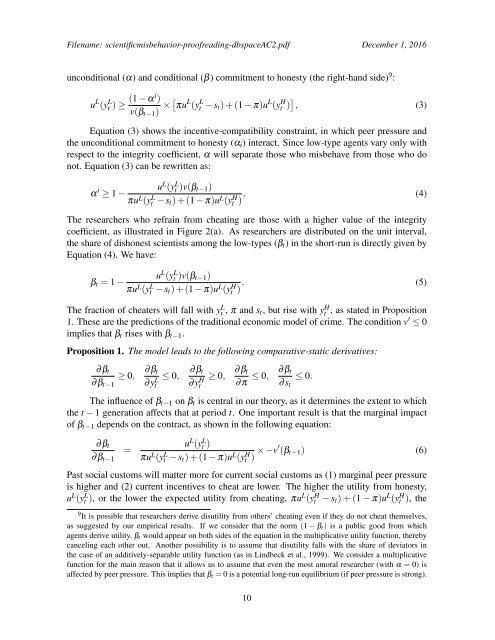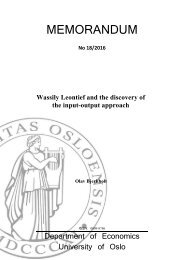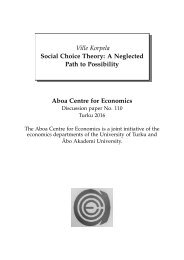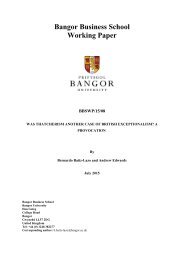Cheat Perish? A Theory Scientific Customs
n?u=RePEc:tut:cccrwp:2016-03-ccr&r=hpe
n?u=RePEc:tut:cccrwp:2016-03-ccr&r=hpe
Create successful ePaper yourself
Turn your PDF publications into a flip-book with our unique Google optimized e-Paper software.
Filename: scientificmisbehavior-proofreading-dbspaceAC2.pdf December 1, 2016<br />
unconditional (α) and conditional (β) commitment to honesty (the right-hand side) 9 :<br />
u L (y L t ) ≥ (1 − αi )<br />
v(β t−1 ) × [ πu L (y L t − s t ) + (1 − π)u L (y H t ) ] , (3)<br />
Equation (3) shows the incentive-compatibility constraint, in which peer pressure and<br />
the unconditional commitment to honesty (α i ) interact. Since low-type agents vary only with<br />
respect to the integrity coefficient, α will separate those who misbehave from those who do<br />
not. Equation (3) can be rewritten as:<br />
α i ≥ 1 −<br />
u L (y L t )v(β t−1 )<br />
πu L (y L t − s t ) + (1 − π)u L (y H t ) , (4)<br />
The researchers who refrain from cheating are those with a higher value of the integrity<br />
coefficient, as illustrated in Figure 2(a). As researchers are distributed on the unit interval,<br />
the share of dishonest scientists among the low-types (β t ) in the short-run is directly given by<br />
Equation (4). We have:<br />
β t = 1 −<br />
u L (y L t )v(β t−1 )<br />
πu L (y L t − s t ) + (1 − π)u L (y H t ) . (5)<br />
The fraction of cheaters will fall with y L t , π and s t , but rise with y H t , as stated in Proposition<br />
1. These are the predictions of the traditional economic model of crime. The condition v ′ ≤ 0<br />
implies that β t rises with β t−1 .<br />
Proposition 1. The model leads to the following comparative-static derivatives:<br />
∂β t<br />
∂β t−1<br />
≥ 0,<br />
∂β t<br />
∂y L t<br />
≤ 0,<br />
∂β t<br />
∂y H t<br />
≥ 0,<br />
∂β t<br />
∂π ≤ 0,<br />
∂β t<br />
∂s t<br />
≤ 0.<br />
The influence of β t−1 on β t is central in our theory, as it determines the extent to which<br />
the t − 1 generation affects that at period t. One important result is that the marginal impact<br />
of β t−1 depends on the contract, as shown in the following equation:<br />
∂β t<br />
∂β t−1<br />
=<br />
u L (y L t )<br />
πu L (y L t − s t ) + (1 − π)u L (y H t ) × −v′ (β t−1 ) (6)<br />
Past social customs will matter more for current social customs as (1) marginal peer pressure<br />
is higher and (2) current incentives to cheat are lower. The higher the utility from honesty,<br />
u L (yt L ), or the lower the expected utility from cheating, πu L (yt<br />
H − s t ) + (1 − π)u L (yt H ), the<br />
9 It is possible that researchers derive disutility from others’ cheating even if they do not cheat themselves,<br />
as suggested by our empirical results. If we consider that the norm (1 − β t ) is a public good from which<br />
agents derive utility, β t would appear on both sides of the equation in the multiplicative utility function, thereby<br />
canceling each other out. Another possibility is to assume that disutility falls with the share of deviators in<br />
the case of an additively-separable utility function (as in Lindbeck et al., 1999). We consider a multiplicative<br />
function for the main reason that it allows us to assume that even the most amoral researcher (with α = 0) is<br />
affected by peer pressure. This implies that β t = 0 is a potential long-run equilibrium (if peer pressure is strong).<br />
10





